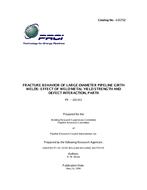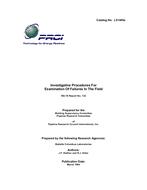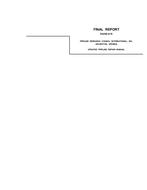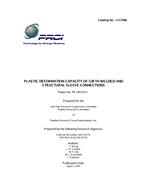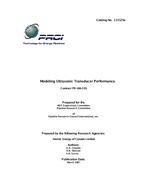Provide PDF Format
PRCI PR-202-011
- Fracture Behavior of Large-Diameter Pipeline Girth Welds: Effect of Weld Metal Yield Strength and Defect Interaction, Part II
- Report / Survey by Pipeline Research Council International, 05/24/1994
- Publisher: PRCI
$498.00$995.00
L51712e
University of Gent-Belgian Welding Institute
(e-book version)Need: Fitness for purpose girth defect assessments assume the presence of a single defect. This assumption is not always fulfilled. Welds may contain many small defects. These defects, when considered individually and without interaction, are generally innocuous. However, this may be a false conclusion as to the true strength or deformation capacity of the weld because neighbouring imperfections or defects may interact and may be more severe than each individual imperfection. When non-destructive examinations reveal multiple defects, a defect recategorisation procedure has to be applied to determine whether neighbouring defects will interact other under load. The interaction criteria of BS PD6493, ASME Boiler and Pressure Vessel Code Section XI and the Japanese fitness-of-purpose code WES 2805 are based on a combination of linear elastic fracture mechanics calculations and engineering judgement. The PD6493 and ASME XI rules are based on the principle that the increase in the stress intensity magnification caused by interaction of neigbouring defects should be limited to 20% (PD 6493) and 6% (ASME XI), whereas the WES criterion is based on the principle that the stress intensity magnification or CTOD value of the interacting neighbouring defects should be limited to 20% of the shortest defect. As the fracture behaviour of line pipe girth welds differs from linear elastic behaviour, it is expected that the existing rules are not necessarily applicable for elastic-plastic or plastic material behaviours. This consideration suggests that there exist a need for developing criteria which permit plasticity effects to be incorporated. The mathematical treatment of multiple defects under elastic-plastic and or plastic fracture conditions is a complex issue because it is not possible to predict yielding behaviour and make a distinction between local and ligament collapse. Because of this limitation, it is thus necessary to employ large scale tensile tests in which the interaction effects can be reproduced. In persuing this approach, it is further possible: (a) to verify and establish the conservatism built into the existing interaction criteria. (b) to formulate alternative interaction criteria for elastic-plastic or plastic behaviour.
Benefit: The goal of this study was to obtain information on the failure behavior of girth welds containing two coplanar fatigue pre-cracked defects. The results were correlated with tests on welds containing a single crack to determine the engineering significance of existing defect interaction rules under elastic-plastic and plastic fracture conditions.
Result: This study led to the following conclusions: (1) The failure characteristics of a girth weld is sensitive to crack size and the degree of weld metal strength overmatching; (2) Cracks in a girth weld joining pipes of different yield strengths can sustain greater overall failure strains than in those a weld joining similar pipes; (3) Girth weld failure can be preceded by Gross Selection Yielding (GSY) provided the weld metal is overmatching in yield strength; and (4) Existing defect interaction rules were overly conservative for defects in overmatching weld metal. See Report L51652 for part one.
University of Gent-Belgian Welding Institute
(e-book version)Need: Fitness for purpose girth defect assessments assume the presence of a single defect. This assumption is not always fulfilled. Welds may contain many small defects. These defects, when considered individually and without interaction, are generally innocuous. However, this may be a false conclusion as to the true strength or deformation capacity of the weld because neighbouring imperfections or defects may interact and may be more severe than each individual imperfection. When non-destructive examinations reveal multiple defects, a defect recategorisation procedure has to be applied to determine whether neighbouring defects will interact other under load. The interaction criteria of BS PD6493, ASME Boiler and Pressure Vessel Code Section XI and the Japanese fitness-of-purpose code WES 2805 are based on a combination of linear elastic fracture mechanics calculations and engineering judgement. The PD6493 and ASME XI rules are based on the principle that the increase in the stress intensity magnification caused by interaction of neigbouring defects should be limited to 20% (PD 6493) and 6% (ASME XI), whereas the WES criterion is based on the principle that the stress intensity magnification or CTOD value of the interacting neighbouring defects should be limited to 20% of the shortest defect. As the fracture behaviour of line pipe girth welds differs from linear elastic behaviour, it is expected that the existing rules are not necessarily applicable for elastic-plastic or plastic material behaviours. This consideration suggests that there exist a need for developing criteria which permit plasticity effects to be incorporated. The mathematical treatment of multiple defects under elastic-plastic and or plastic fracture conditions is a complex issue because it is not possible to predict yielding behaviour and make a distinction between local and ligament collapse. Because of this limitation, it is thus necessary to employ large scale tensile tests in which the interaction effects can be reproduced. In persuing this approach, it is further possible: (a) to verify and establish the conservatism built into the existing interaction criteria. (b) to formulate alternative interaction criteria for elastic-plastic or plastic behaviour.
Benefit: The goal of this study was to obtain information on the failure behavior of girth welds containing two coplanar fatigue pre-cracked defects. The results were correlated with tests on welds containing a single crack to determine the engineering significance of existing defect interaction rules under elastic-plastic and plastic fracture conditions.
Result: This study led to the following conclusions: (1) The failure characteristics of a girth weld is sensitive to crack size and the degree of weld metal strength overmatching; (2) Cracks in a girth weld joining pipes of different yield strengths can sustain greater overall failure strains than in those a weld joining similar pipes; (3) Girth weld failure can be preceded by Gross Selection Yielding (GSY) provided the weld metal is overmatching in yield strength; and (4) Existing defect interaction rules were overly conservative for defects in overmatching weld metal. See Report L51652 for part one.
Related Products
PRCI PR-185-9211
Plastic Deformation Capacity of Girth-Welded and Structural Sleeve Connections..
$498.00 $995.00

